Understanding Drysuits in Kitesurfing Adventures
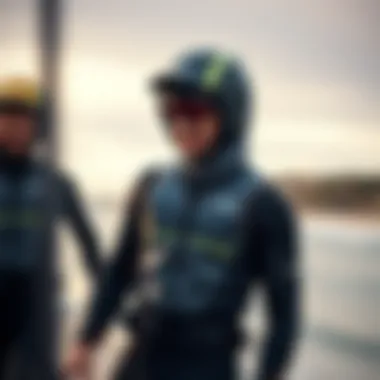
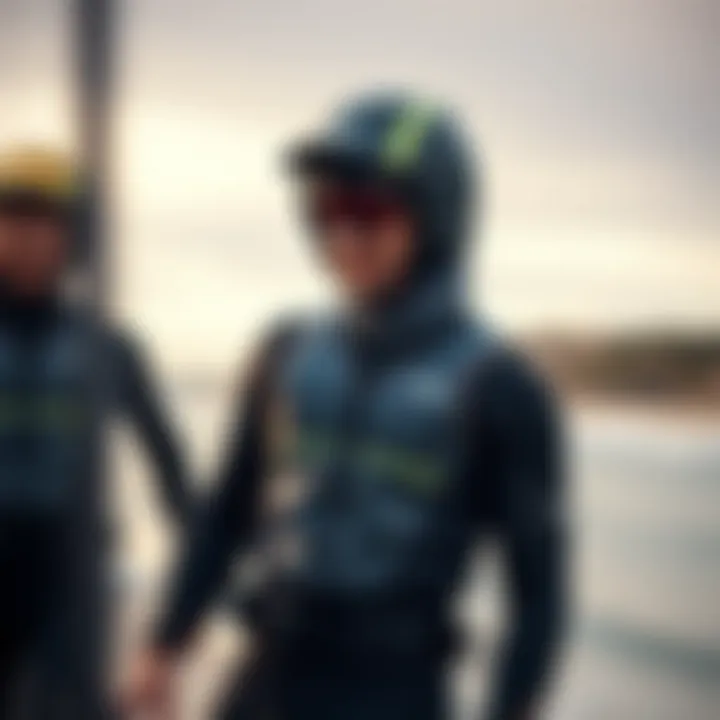
Intro
In the world of kitesurfing, one of the most frequent questions newcomers ask is how to stay warm and protected while enjoying this exciting water sport. With various factors coming into play, such as temperature drops and changing weather conditions, the right gear becomes crucial. This is where drysuits step in, offering a layer of insulation and protection that can make a significant difference in performance and overall experience.
Drysuits, designed to keep water out, have grown in popularity among kitesurfers. Not only do they provide warmth during colder months, but they also allow for flexibility and comfort in movement. In this article, we will explore the significance of drysuits in kitesurfing, focusing on their functionalities, construction, and the advantages they present in different scenarios. Whether you're an eager beginner or a seasoned kiteboarding fanatic, understanding the role of drysuits will equip you with valuable insights for your adventures on the water.
Gear and Equipment
When it comes to kitesurfing, kitesurfers must assemble a reliable kit that enhances their performance and safety on the water. This gear includes everything from the kite and board to harnesses and, of course, drysuits.
Essential Kiteboarding Gear for Beginners
For those just stepping foot into the world of kitesurfing, it's essential to gather the foundational gear to ensure a fun and safe learning experience. Key pieces include:
- Kite: Depending on the wind conditions, new riders should start with a smaller kite for better control.
- Board: A beginner board, often larger and more stable, helps riders get comfortable on the water.
- Harness: Look for a comfortable waist or seat harness that allows easy movement.
- Drysuit: An entry-level drysuit that fits well can keep the chill out in cooler waters.
- Safety Leash: This connects the rider to the kite and is crucial for quick releases.
Having reliable gear helps build confidence, enabling newbies to focus on learning techniques without distractions.
Advanced Equipment for Experienced Riders
As riders progress, they tend to refine their gear choices for optimal performance. Experienced kitesurfers often look for:
- Advanced Kites: These are designed for responsiveness and performance, catering to specific styles like freestyle or wave riding.
- Performance Boards: Thinner and lighter boards assist in speed and maneuverability.
- Upgraded Harnesses: With improved support and comfort, these allow for longer sessions on the water.
- High-quality Drysuits: Professional riders may invest in more advanced drysuits, which utilize lightweight, flexible materials designed for maximum mobility.
An important aspect to note is that gear evolves based on individual preferences and local conditions. Riders must stay informed and adjust gear accordingly, ensuring practitioners maximize their enjoyment of the sport while maintaining their safety.
"Investing in the right gear is not just about comfort, it can also save lives. Always prioritize safety over trends."
Techniques and Tips
Arming oneself with the right information and techniques can drastically improve the kitesurfing experience. This is even more significant when considering that kitesurfing combines elements of surfing and flying, making it essential to balance thrill and caution.
Safety Practices for Kiteboarding
Safety should always be top of mind while hitting the water, especially when kiting. Here are a few common practices:
- Check Local Conditions: Always assess wind speeds and water conditions before heading out.
- Buddy System: Kiteboarding with a partner can provide support in emergencies.
- Wear a Helmet: Protecting your head can mitigate injury from falls or collisions.
- Know Your Limits: Avoid pushing boundaries, especially in challenging conditions.
Training Techniques to Improve Your Skills
Continual learning and improvement can greatly enhance your kitesurfing ability. Some techniques include:
- Drill Core Skills: Focus on essential maneuvers, whether it’s jumps or turns.
- Watch Tutorials: Video resources are abundant, and they can provide visual cues that are beneficial for techniques.
- Take Lessons: Investing in lessons can provide targeted feedback and accelerate skill development.
Knowing how to stay safe and improve on the water can make all the difference. This knowledge not only keeps riders safe but fosters a community of responsible and skilled kitesurfers.
The End
Prologue to Drysuits in Kitesurfing
Kitesurfing is a thrilling sport that pulls enthusiasts into the sun-kissed water, but with that excitement comes an ever-present concern: safety and comfort in variable weather conditions. This is where drysuits step into the spotlight. These specialized garments do more than merely keep one dry; they redefine how kiteboarders interact with their environment. In many cases, slipping into a drysuit is what separates a refreshing ride from an uncomfortable, bone-chilling ordeal.
Drysuits provide a barrier between the body and the elements. When the temperature dips or the wind picks up, especially in diverse climates, kitesurfers who are properly outfitted can focus on their performance rather than enduring discomfort or risking hypothermia. Ultimately, investing in a quality drysuit can enhance the overall kitesurfing experience, allowing riders to confidently navigate the waves, no matter the season.
Elemental Benefits of Drysuits
The importance of drysuits in kitesurfing doesn’t just stem from their protective qualities; they also offer various features that amplify a rider’s performance and safety. Firstly, with their snug fit, these suits allow for extended mobility without feeling constricted. You won't find yourself wrestling with bulky layers while trying to maneuver through challenging conditions. Secondly, their insulation properties help maintain optimal body temperature, safeguarding against the sudden chill of ocean waters.
Another significant factor is their versatility; drysuits can be worn in diverse conditions, whether you're braving the biting cold of winter or navigating milder spring days. This adaptability makes them invaluable for kitesurfers at any skill level.
"Wearing a drysuit is like having a second skin that shields you from the water while letting you feel free to ride."
An Ounce of Prevention
Moreover, wearing a drysuit is not just about comfort; it’s also about safety. A well-designed drysuit can provide buoyancy assistance, potentially giving riders that crucial float during an unexpected fall. Visibility features, such as reflective patches, can help keep riders seen in turbulent conditions. Keeping these safety elements in mind, it’s clear that the decision to utilize a drysuit can make a vast difference in risk management during kitesurfing.
In summary, understanding the importance of drysuits in kitesurfing is vital for any serious kiteboarder. No longer a mere accessory, drysuits are essential gear that combines protection, comfort, and style. They help navigate various conditions with assurance, allowing enthusiasts to immerse themselves in the exhilarating world of kitesurfing without the looming fears of the elements.
Understanding the Drysuit: A Technical Overview
The heart of a successful kitesurfing experience often lies not just in skill or the board itself but also in the gear you wear. A drysuit plays a pivotal role, especially when the winds pick up and the water temperature drops. Understanding the mechanics of drysuits is essential for kitesurfers looking to optimize their performance and comfort on the water. This section dives into the construction materials and types of drysuits available, shedding light on aspects that can significantly impact your kitesurfing adventure.
Construction Materials of Drysuits
The materials used to craft a drysuit determine its functionality, comfort, and durability. Two prominent options are neoprene and latex.
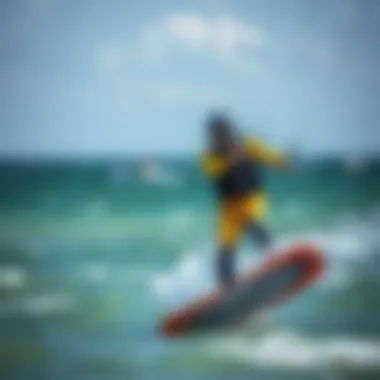
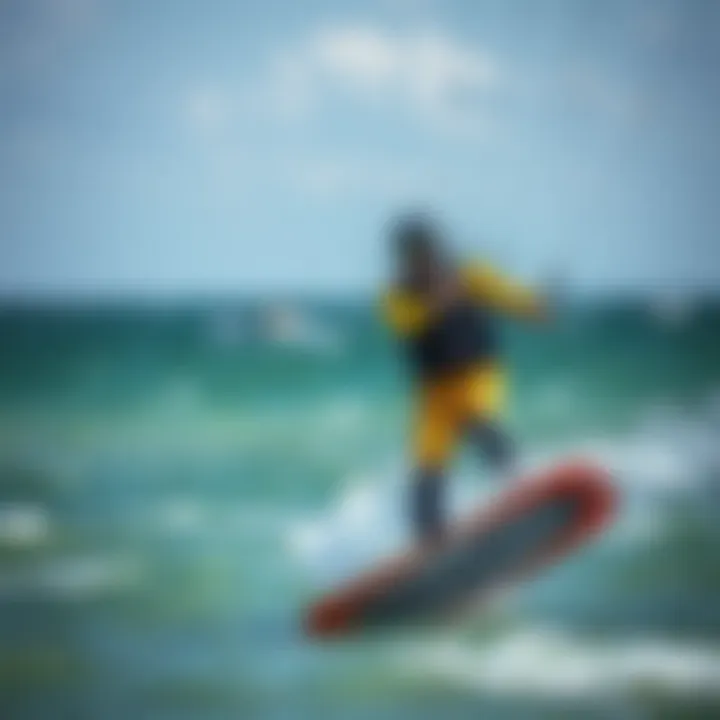
Neoprene vs. Latex
Neoprene is probably one of the most recognized materials in water sports gear. Its elasticity provides excellent insulation by trapping a thin layer of water against the skin, which then warms up with body heat. This feature keeps a kitesurfer warm even in cooler conditions. On the flipside, latex is often used in seals because it offers a tighter fit, minimizing water entry points.
The key here is balance. A neoprene drysuit allows for some internal moisture but manages to keep you warm by utilizing your body heat. Latex, however, is unforgiving if you get caught in the wrong weather. It offers outstanding waterproof capabilities, a must-have for certain conditions, but lacks that stretchiness you might find with neoprene. The right choice ultimately hinges on your specific needs, like temperature conditions and how much mobility you prefer.
Glued vs. Taped Seams
Seams often take a backseat in discussions about drysuits, but their construction can make a significant difference. Drysuits can either feature glued seams or taped seams. Glued seams are created by adhering the materials together with a strong adhesive. This method creates a flat seam, which is less likely to cause discomfort against the skin. Taped seams, on the other hand, use a layer of tape placed over the stitched seams to provide an extra layer of waterproofing.
The advantage of glued seams lies in their ability to create a smoother surface, reducing irritation. Taped seams, however, are celebrated for their comprehensive waterproofness, which can be crucial during long sessions on the water. Each style has its merits, and understanding their differences can influence buying decisions.
Types of Drysuits Available
A dive into the world of drysuits isn't complete without examining the varieties available today. Different designs cater to specific needs and preferences.
Front Zip vs. Back Zip
Drysuits come with various zipper configurations. Front zip suits offer easier entry and exit, giving the user greater autonomy when dressing. Being able to easily don the suit can save valuable time, especially when conditions change rapidly.
Back zip drysuits, while sometimes tricky to put on, generally offer a cleaner look and may excel in terms of waterproof integrity. The choice between the two often comes down to personal preference and how much assistance one needs when gearing up.
Fluid vs. Non-Fluid Models
Not all drysuits keep you dry for the same reasons. Fluid models are designed to circulate a small amount of water within the suit, acting much like a second layer of skin that helps with temperature regulation. In contrast, non-fluid models strive for completely insulated dry conditions, ideal for very cold waters. The decision here depends largely on your environment: if you're facing frigid waters, a non-fluid model may be your best bet.
Each type of drysuit comes with its own set of advantages and drawbacks, forcing kitesurfers to weigh their options and think critically about what they truly need for their adventures.
"Choosing the right drysuit can mean the difference between an exhilarating ride and a miserable session on the water."
Benefits of Using a Drysuit
When it comes to kitesurfing, the conditions can shift faster than the wind can change direction. A drysuit offers various advantages that can make or break your experience on the water. Let’s explore how a drysuit not only keeps you comfortable but also enhances your overall kitesurfing experience.
Temperature Regulation
Insulation Properties
A critical aspect of temperature regulation in kitesurfing is insulation. Drysuits are designed to provide a barrier against the cold, trapping a layer of warm air close to the body. This is particularly important for kiteboarders who surf in colder climates where temperatures can plunge. Often made from materials like neoprene, these suits stand out for their ability to maintain warmth without feeling like you’re swimming in a lead suit. Even when water splashes in, the thermal layer remains effective, which is a key characteristic that enhances comfort while riding the waves.
However, it’s important to note that not all insulation is created equal. The thickness of the material can dictate how warm you will feel. While thicker suits can provide more warmth, they might also restrict mobility, which can be a downside if you need to maneuver quickly in the water.
Wicking Technology
Another game-changer is wicking technology. This feature helps draw moisture away from your body, which is especially beneficial during intense physical activities like kiteboarding. By keeping sweat from pooling inside the suit, you maintain a dry and comfortable environment which is key to performance. The lightweight fabrics utilized in this technology ensure you don’t weigh yourself down with excess water or sweat.
However, like insulation, the effectiveness of wicking can vary among different drysuits. Some cheaper models may not employ this technology effectively, which could lead to discomfort over time as sweat accumulates.
Enhanced Mobility
Freedom of Movement
One of the top concerns for any active kitesurfer is freedom of movement. Drysuits can feel constricting if not designed properly. However, modern drysuits prioritize an ergonomic fit that allows a full range of motion. Features like articulated joints or gusseted underarms can enable kiteboarders to twist and turn without feeling like they’re in a straightjacket.
This mobility is crucial when you're in a dynamic environment like the ocean, where quick movements can mean the difference between a successful ride and a wipeout. While many kitesurfers worry that drysuits hinder performance, well-designed options can allow for agility without sacrificing warmth or protection.
Design Considerations
It’s worth noting how design impacts functionality. A good drysuit should include streamlined elements that minimize drag. This means paying attention to the suit's profile and ensuring that it fits snugly yet comfortably. Some suits even come with strategically placed zippers and bungee cord adjustments to fine-tune fit. While all these enhancements can drive the cost up, investing in a well-designed suit can pay off in both comfort and performance.
Safety Features
Buoyancy Assistance
Safety is paramount in adventure sports, and drysuits often incorporate buoyancy assistance. Some varieties come with built-in buoyancy aids that can provide extra flotation. It's a feature that can be particularly reassuring when navigating unfamiliar waters or turbulent conditions.
Yet, this added safety also comes with a responsibility. Surfers need to understand how buoyancy can affect their posture and balance while kitesurfing. A suit that is too buoyant may lift your torso out of the water, causing instability when you take off or land jumps.
Visibility Enhancements
Visibility during kitesurfing cannot be overstated. Drysuits often include reflective elements which help increase visibility in low-light conditions or busy waterway situations. Bright colors are a common design choice to ensure that you stand out against the water. Especially if you're riding during sunrise or sunset, being seen is not just about safety; it’s crucial for other water users too.
That said, some kitesurfers may prefer more subdued colors for aesthetic reasons. Thus, it’s essential to strike a balance between personal style and safety when selecting your suit.
The advantages that come with using a drysuit are significant; they go beyond simply keeping you warm. From insulation and wicking to mobility and safety features, choosing the right drysuit can profoundly impact your kitesurfing experience.
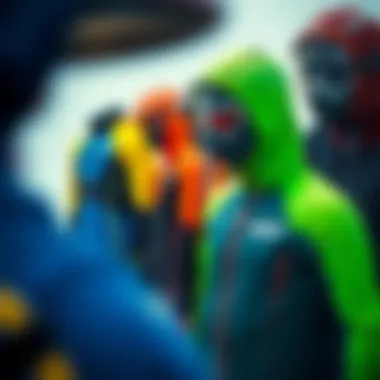

Choosing the Right Drysuit for Kitesurfing
Choosing the right drysuit is crucial for anyone involved in kitesurfing, especially since the sport occurs in diverse weather conditions and water temperatures. A suitable drysuit can significantly enhance your comfort and safety on the water. With so many options on the market, it becomes necessary to focus on specific aspects to make an informed decision. The following factors are often overlooked yet play an essential role in your kitesurfing experience.
Factors to Consider
Water Temperature
When deciding on a drysuit, understanding water temperature is one of the top priorities. Cold water can lower your body temperature quickly, increasing the risk of hypothermia. A good drysuit acts as a barrier against the chill, keeping the rider warm and focused during their session.
The key characteristic of a drysuit designed for cold water use is insulation. Drysuits made for extreme conditions usually incorporate layers that can trap warmth while allowing moisture to escape. This feature is beneficial because it adds comfort during prolonged periods in frigid water.
However, it can be challenging to find the right balance between insulation and mobility. Too much insulation can restrict your movement, which isn’t ideal for performing tricks on the water. Thus, while insulating features are crucial, they should not compromise your freedom to move.
Personal Fit and Comfort
The importance of personal fit and comfort cannot be overstated when selecting a drysuit. A suit that fits snugly will minimize water entry and improve thermal regulation, which is vital during those long hours on the water.
An excellent drysuit generally features adjustable components, like wrist and ankle seals, which help keep the water out. A customized fit means you can effectively engage in your sport without distractions caused by discomfort or shifting material. This unique feature is especially beneficial for kitesurfers, as any misfit could lead to reduced agility when you’re trying to catch that perfect wave.
On the downside, finding the right fit can be a time-consuming process. Not every brand offers a wide range of sizes, leading to potential compromises on comfort. However, achieving the perfect fit should be a priority.
Brand Recommendations
Top Manufacturers
The market has several reputable manufacturers specializing in kitesurfing drysuits. Some of the top names include Xcel, O'Neill, and Billabong. These brands are known for their innovative designs and commitment to quality.
The key aspect of these manufacturers is their focus on technological advancements. For example, many integrate special waterproof technologies and ventilating systems that ensure comfort without compromising insulation. This practice has made them a popular choice among both beginners and seasoned kitesurfers.
Although high-quality suits may come with a higher price tag, the investment is often worth the long-term benefits. Durable material and craftsmanship not only enhance performance but can withstand the harsh marine conditions.
Reviews of Popular Models
Exploring user reviews of popular drysuit models is an invaluable resource as it provides insights from those who've already put the suits through their paces. Models such as the Xcel Drylock or the O'Neill Epic showcase excellent reviews highlighting their versatility and comfort.
These reviews usually mention their features, such as stretchable fabrics, glued seams, and efficient layering technology. Picking a model with good testimonials can significantly reduce the chances of buyer's remorse.
However, potential buyers should look at a range of reviews to get a balanced understanding. Some users might have specific preferences that don't generalize well for everyone. Therefore, being proactive in researching will lead to a more satisfying choice in your drysuit.
Drysuit Care and Maintenance
Caring for your drysuit isn’t just about keeping it looking sharp; it’s about ensuring its functionality and longevity. Like any piece of gear you take into the unpredictable mettle of the ocean, a well-maintained drysuit heightens safety and enhances performance. Proper care can prevent costly mishaps and ensure that your warmth isn’t compromised when you’re out kiteboarding in chilly waters.
Routine Inspection and Cleaning
Best Practices for Cleaning
Cleaning your drysuit goes beyond a simple rinse-off after a day in the water. Regular inspection and thorough cleaning can contribute significantly to its lifespan. Following a structured cleaning routine is essential. Ideally, after every use, you should:
- Rinse it with fresh water to wash away salt, sand, or any harsh residues.
- Use a mild detergent specifically formulated for wetsuits and drysuits, as heavy chemicals can degrade the fabric.
One of the standout characteristics of this cleaning approach is the focus on maintaining fabric integrity. Gently scrub areas prone to dirt buildup, like cuffs and zippers, but avoid harsh bristle brushes. A soft sponge does wonders without causing damage. The obvious benefit here is that it helps in preserving the suit's waterproof features, ensuring that every part of it functions effectively when you head back out.
Unique Feature: Perhaps the most beneficial aspect of proper cleaning is the prevention of odors and degradation that can occur from neglect. While it may add a bit of time to your post-session routine, getting into this habit yields a drysuit that remains comfortable and reliable – a crucial point for any serious kitesurfer.
Storage Tips
Where you store your drysuit significantly influences its performance and durability. Avoid folding or stuffing your drysuit in a cramped space; instead, hang it up in a cool, dry location. Using a padded hanger prevents creasing that can lead to damage over time.
A key characteristic of effective storage is keeping the suit away from direct sunlight and heat sources. Sun can degrade the material, while heat can break down adhesives and seals used in drysuit construction. Opt for a storage bag that wicks away moisture rather than one that traps it.
Unique Feature: The proper storage method comes with the added advantage of easy access. You won’t find yourself fumbling around for a wrinkled or disheveled suit before your next adventure, keeping your prep to a minimum and your excitement at a maximum.
Troubleshooting Common Issues
When it comes to using drysuits, encountering issues is quite common, but knowing how to troubleshoot can save the day.
Leak Detection
A leak in your drysuit can be a total game changer, especially on a cold day. Detecting leaks early is crucial for avoiding unexpected shivers during your session. To check for leaks, it’s smart to inspect it visually for any punctures or tears. Also, perform a simple water test: fill the suit with air, and check if bubbles escape either by submerging it or using a spray bottle.
The benefit of this approach is that it can help you catch small issues before they escalate. The characteristic of being proactive about leaks means you can enjoy your kitesurfing escapades with peace of mind. Minimizing water ingress not only prevents discomfort, but it also extends the life of your drysuit.
Unique Feature: Early detection is far more cost-effective than waiting until you are soaking wet in the middle of a session, which can lead to serious safety hazards down the road.
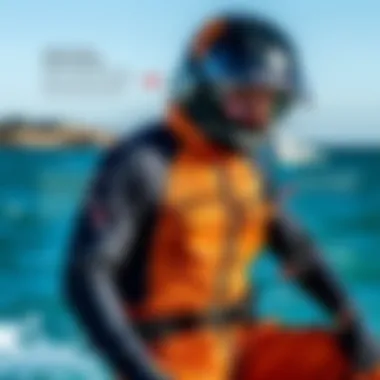
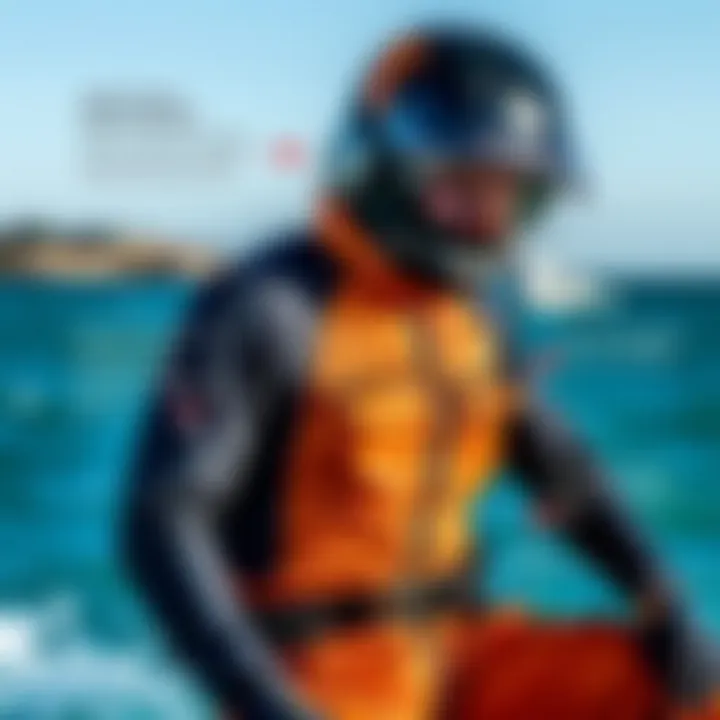
Zipper Maintenance
Zippers are often the weak link in the chain of drysuit functionality. If not kept in tip-top shape, your zipper can become a source of frustration and leakage. A solid maintenance routine involves:
- Zipping and unzipping gently to avert snagging.
- Occasionally applying a lubricant made for drysuit zippers to keep them functioning smoothly.
- Cleaning the zipper area after use to minimize grit buildup.
The main advantage of a well-maintained zipper is that it ensures a snug fit to keep that chilly water out. The characteristic of reliability in your zipper allows you to focus on your performance rather than worrying about any mid-ride surprises.
Unique Feature: Regular maintenance can even prolong the life of the zipper, saving you from the added expense of repairs or replacements and preventing interruptions in your kitesurfing activities.
Addressing Myths Surrounding Drysuits
When people think about kitesurfing in cold conditions, misunderstandings about drysuits can often pop up. It's essential to clarify these misconceptions to ensure that both new and seasoned kiteboarders feel confident in their gear choices. By addressing these myths, we can encourage a more informed approach to safety and comfort in the sport. Let's dive into a couple of the most prevalent concerns.
Overheating Concerns
One common belief is that wearing a drysuit will leave you feeling like a boiled lobster under the sun. The idea here is that these suits are designed to keep water out, so maybe they don’t “breathe”? This isn't quite the whole story. Modern drysuits are designed with breathability in mind. They feature ventilation systems, like zippers in the underarms, or neoprene panels which allow for some air circulation, making them versatile for various temperatures.
Moreover, proper layering inside the drysuit plays a crucial role in temperature management. For instance, combining moisture-wicking base layers with insulating materials can help manage heat effectively. This means you’re less likely to overheat than if you went in with just a tee shirt and board shorts. The key takeaway? Understand your own body’s needs, and don't shy away from experimenting with layers.
Weight and Bulkiness Misconceptions
Another myth lies in the perception of drysuits being hefty and cumbersome. Many think that putting one on is akin to wearing a suit of armor. In reality, advancements in drysuit technology have resulted in incredibly lightweight designs. The materials used today can provide an optimal balance of durability without excessive weight.
Typically, when folks are thinking about bulkiness, they might have last year’s model or even older designs in mind. Many modern drysuits are streamlined, focusing not just on warmth but also on flexibility and freedom of movement. A well-fitted drysuit should feel natural and allow you to move as if you weren’t wearing anything at all.
To put it simply, if you’re considering kitesurfing in chilly waters, a drysuit should be viewed almost like an additional skin rather than a heavy layer. Instead of limiting movement, it can enhance your confidence on the board.
Remember, being properly equipped with accurate information is just as vital as having the right gear when pursuing your passion for kitesurfing.
As we debunk these myths, we broaden our understanding, paving the way for better experiences on the water. After all, a drysuit is not just a piece of gear; it’s an essential tool that can transform a cold day into a thrilling adventure.
Experiencing Different Conditions
Cold Water Kitesurfing
Importance of a Drysuit in Cold Water
When kitesurfing in chilly waters, wearing a drysuit is not just an option—it's a necessity. The primary goal of a drysuit is to maintain body warmth by minimizing exposure to cold water. Unlike regular wetsuits, which allow a certain amount of water to enter and then trap it against your skin, drysuits create a barrier, preventing water from seeping in. This characteristic is invaluable in frigid environments where hypothermia can be a serious risk. Moreover, drysuits often incorporate insulated linings that further enhance warmth while maintaining mobility, which allows for smooth and fluid movement while kitesurfing.
One remarkable feature of drysuits designed for cold water kitesurfing is their flexibility. Many models have articulated joints to allow maneuverability without compromising on warmth. This balance between insulation and mobility is what makes drysuits a popular choice for riders braving colder conditions. Essentially, a quality drysuit acts like a second skin, enabling kiteboarders to perform confidently in lower temperatures without fear of losing body heat.
Layering Techniques
Layering can significantly amplify the benefits of a drysuit in cold water. This technique involves wearing specific thermal garments beneath the drysuit that work together to provide enhanced insulation. Base layers made from moisture-wicking materials pull sweat away from your skin, while mid-layers often let a body’s heat build up, effectively keeping you warm. Depending on the water temperature, you can adjust the number of layers—two or three layers may be ideal for extremely cold conditions.
The beauty of layering is its versatility. Anyone can modify their setup according to personal comfort and the nature of the kitesurfing session. However, it’s crucial to maintain a balance; over-layering could lead to restricted movement and excessive sweating. Hence, selecting the right layers can enhance performance while keeping you comfortable throughout your time on the water.
Storm and Wind Considerations
Durability in Harsh Conditions
When faced with stormy weather, the durability of a drysuit is paramount. A suit built to withstand harsh conditions should have reinforced seams, sturdy zippers, and high-quality fabric that can resist abrasions from wind, water, and potential debris in the air. Drysuits like those crafted from ripstop materials enhance their resilience against tears and punctures, important features for those who engage in kitesurfing during less stable weather conditions.
Choosing a durable drysuit not only assures longevity but also plays a role in your safety. A reliable suit mitigates the risk of accidental leaks, which can be a real concern in turbulent environments. Having confidence that your gear can hold up in challenging weather lets the rider focus on technique and navigation rather than worrying about their equipment failing.
Safety Precautions
Being safe while kitesurfing in adverse conditions goes hand-in-hand with using a properly fitted drysuit. The suit provides buoyancy assistance, helping you stay afloat in case of an unexpected spill in the water. Moreover, many modern drysuits come equipped with reflective strips and bright colors to enhance visibility, which is critical in stormy or overcast conditions.
An equally vital aspect of safety is ensuring that your drysuit fits well. A loose suit can balloon up and cause difficulty in movement or righting oneself in the water. Conversely, a suit that is too tight can restrict blood circulation and make it tough to maneuver. Engaging with professionals when selecting a drysuit can help achieve that perfect fit, combining safety with optimal performance.
"Safety and comfort are not just luxury; they're essential for every kitesurfing session, especially in unpredictable conditions."
For further insights, you can refer to the ongoing discussions about kitesurfing gear at Reddit Kitesurf or find resources related to drysuits at Wikipedia.
The End: The Integral Role of Drysuits
As we wrap up our exploration of drysuits, it becomes clear that these garments play a pivotal role in the kitesurfing experience. Whether you're skimming across the waves on a brisk winter day or navigating through unexpected weather changes, a drysuit not only enhances performance but also significantly contributes to safety.
One of the most critical elements to consider is temperature regulation. Drysuits effectively create a barrier against the cold, ensuring that kitesurfers maintain a comfortable body temperature even in frigid waters. This insulation potential is indispensable for those who find themselves riding the waves beyond the summer months.
Furthermore, the design and technology involved in drysuit construction have evolved over the years. New materials have emerged, allowing for greater flexibility and reduced bulk. Without compromising on protection, modern drysuits now boast improved breathability and damping properties, enhancing the rider's mobility. The integration of wicking technologies also adds to this comfort, making it easier to manage sweat and moisture.
In terms of safety, drysuits don't just keep you dry; they also offer buoyancy assistance. Should the worst happen and you find yourself in the water unexpectedly, a drysuit can help keep you afloat until help arrives. Additionally, many designs come with high-visibility colors or reflectors— a must-have when conditions turn stormy or cloudy.
When choosing a drysuit, understanding your personal fit and comfort becomes paramount. Given the variance in body shapes and sizes, opting for a suit that feels right on your body can enhance your overall kitesurfing experience. Knowing the right materials and suit styles that best suit different conditions can further refine each session.
As you gear up for your next kitesurfing adventure, remember that your swimsuit choice can make or break the experience. With proper care and maintenance, your drysuit can serve you loyally through countless thrilling sessions,
"The right gear not only enhances performance but also cultivates confidence to push the limits."



